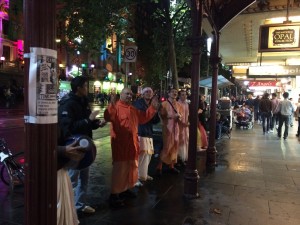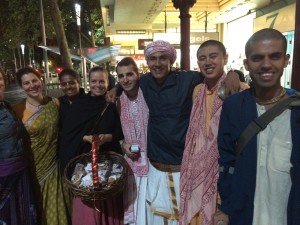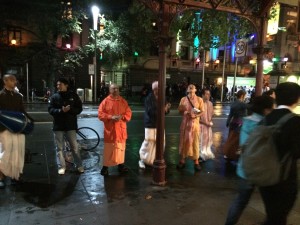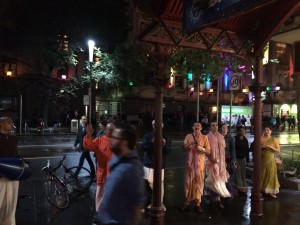The post May 2nd, 2014 – Darshan – Chandan Yatra – Day 1 appeared first on Mayapur.com.
May 2nd, 2014 – Darshan – Chandan Yatra – Day 1
Radhadesh Mellows 2014. Morninglecture by Kadamba Kanana Swami
→ Gouranga TV - The Hare Krishna video collection
Radhadesh Mellows 2014. Morninglecture by Kadamba Kanana Swami
Vyasa-puja 2014
→ KKSBlog

Arrivals and CC evening – 24 Apr 2014
Wednesday and Thursday were the days of arrival for all the devotees who came for the festival. Almost 180 friends and disciples of Kadamba Kanana Swami joined the party and filled the Radhadesh guesthouse and ashrams. It was a lovely sea of devotion and we all had the chance to meet friends.
Kadamba Kanana Swami gave the morning class 24 April, Srimad Bhagavatam 6.4.46.
Download as mp3 (right-click, save as)Later that the evening, Kunti Kumari organized a wonderful evening of Caitanya-Caritramrta katha. First, we had some intro bhajans, afterwards katha on the Caitanya caritramrta and then more bhajan. Finally, Gopali devi dasi was the host in our first CC Quiz. Sutapa’s team won after beating the other teams with the correct answers on even the Extra Hard Questions!!!
Intro CC Bhajans
Download as mp3CC Katha
Download as mp3CC Bhajans part 2
Download as mp3CC Quiz hosted by Gopali dd
Download as mp3In between the CC programs, we had a super tasty dinner organised and prepared by Savitri dd. Our taste buds were going to heaven after relishing the super tasty lasagne and the tiramisu…
Vyasa-puja & Initiations - 25 Apr 2014
The next day the Srimad Bhagavatam class was on 6.4.47 and Kadamba Kanana Swami explained the theme of this festival, “a year of changes”.
Download as mp3At 10h00 the Vyasa-puja festival started with the abhisek, gurvastakam sung by Mayapur Chandradoya dasa and the intro by Sutapa dasa. After the introduction, the next part were the wonderful enlivening offerings, creative poems and even two raps by Gurudas and Prahlad (son of Premalata dd). It was again wonderful to hear all the stories and dedication that everybody shared. Kadamba Kanana Swami commented afterwards on the many offerings and talked about his realizations from our offerings. He quoted Sadbhuja, “We learned through our experiences,” and he explained that he felt the same way. Guru puja was sung by Dwarkadisha dasa and we all took our chance to offer flowers to Kadamba Kanana Swami. He even joined the kirtan afterwards.
Download as mp3The recordings of the whole vyasa-puja festival and offerings can be found here. (password protected)






After fasting comes feasting and we enjoyed a super excellent ekadasi lunch organized & prepared by Pradyumna dasa and his crew. Fried potatoes, two vegetable dishes, kofta, salad, raita and tea. But even if that was not enough, we got the birthday cake which was prepared by Gauravani dd. To top it off, we got shrikhand, carrot halava, oatmeal carob sweets and other milk sweets. Luckily we could eat it all.






Initiations
The schedule was really packed and so was the temple room when the initiation ceremony took place in the afternoon. The yajna was performed by Dhira Krishna das and Kadamba Kanana Swami gave a wonderful introductory class for the initiates.
Download as mp3After the class the ceremony commenced with the name giving of the new initiates.
Initiates *
1. Sundari Sherreitt : Syamasundari devi dasi
2. Annamarija: Arati Devi Dasi
3. Petr Holubar : Purusatraya das
4. Petr Vanek: Purna Tattva das
5. Sibusiso Nkambule : Svayambhu das
6. Angelica Guerrero : Acintya Lila devi dasi
7. Marius Rastauskas : Murari Caitanya das
* known at time of publishing. List subject to change.
And the fire yajna concluded this very busy but very auspicious day only to be superseded by the next big event. The Kings Day Harinam.
After the Kingsday Kadamba Kanana Swami still had energy left to give the morning class on the Caitanya-caritamrta Madhya-lila 22.142.
Download mp3 file
Vaishnava C.A.R.E. Seminar
→ The Toronto Hare Krishna Temple!
Srila Prabhupada displayed the most caring, loving, compassionate and personal qualities! This seminar will be presented by Her Grace Sangita devi dasi, a senior Prabhupada disciple from the U.S. Her grace is a very knowledgeable registered and hospice nurse with many years of medical and spiritual experience. She is also the founder of ISKCON's Vaishnava's C.A.R.E (Counselling, Assistance, Resource and Education for the Terminally Ill and Family) and author of The Final Journey, the most practical guide on passing away of a devotee.
Learn the art of caring for a dying devotee in our community. The following topics and more will be covered:
- Krishna Consciousness and Hospice Philosophy
- Holistic Care for Terminally Ill Devotees
- Communicating with One Who is Dying
- Stages of Loss and Grief
- Personal Awareness Activities
- What is End-of-Life Spiritual Pain?
- How Can YOU Help?
10am-12:30pm - First part of the seminar
12:30pm-1:00pm - Lunch break
1:00pm-3:30pm - Second part of the seminar
Registration is mandatory; please sign up here. Suggested donations are to be determined.
Please join us and learn how you can be part of ISKCON Toronto's first V-Care team.
Stay tuned for more details!
We need ethics to come to goodness
→ The Spiritual Scientist
It is said, ‘tada rajastamo bhavah kamalobhadayas ca ye.’ When one is afflicted with the base material modes of nature, namely rajoguna and tamoguna, then he becomes greedy and lusty. So ethics require to get out of the clutches of greediness and lusty desires. Then he comes to the platform of goodness, which will help him to go to the platform of spiritual life.
Dialectic Spiritualism: A Vedic View of Western Philosophy(Prabhupada Books, 1985), conversation about Socrates
Wednesday, April 30th, 2014
→ The Walking Monk
Please Join The Japa Group
→ Japa Group
Melbourne Harinama
→ Ramai Swami
The Melbourne temple devotees go out on regular harinama downtown and to various suburbs.
The Golden Age – what would it be like?
→ KKSBlog
(Kadamba Kanana Swami, 10 October 2013, Melbourne, Australia, Srimad Bhagavatam 2.3.14)
 It is said that when the yugas are changing, that first there is a sandhya or a joint period. So the first part of the Kali yuga is also the sandhya – the joint period – and it is within that sandhya that the Golden Age of Sri Caitanya Mahaprabhu will begin. It is within that sandhya that there will be a ten thousand year period where the Golden Age would be manifested, as described in the Brahma Vaivarta Purana. It is said that in this age, all the people would be purified by the harinam sankirtan and there will be no longer different varnas, different classes of men, as there will be eka varna hari bhakta – there will be only one class of men, devotees of the Lord.
It is said that when the yugas are changing, that first there is a sandhya or a joint period. So the first part of the Kali yuga is also the sandhya – the joint period – and it is within that sandhya that the Golden Age of Sri Caitanya Mahaprabhu will begin. It is within that sandhya that there will be a ten thousand year period where the Golden Age would be manifested, as described in the Brahma Vaivarta Purana. It is said that in this age, all the people would be purified by the harinam sankirtan and there will be no longer different varnas, different classes of men, as there will be eka varna hari bhakta – there will be only one class of men, devotees of the Lord.
So basically, sometimes we think when the Golden Age comes, then (speaking in a formal voice) Krsna consciousness will become the predominant world religion. In every country, people will be wearing tilak and on every corner, instead of churches and mosques, there will be temples and everyone will pray in Krsna temples. I don’t know… is it going to be like that or is it going to be even more transcendental, is it going to be eka varna hari bhakta – is it going to be totally ecstatic!
Is it just like when someone in the morning walks out of the house with the mrdanga, and someone else sees that, ‘Hey, what’s that?’ and he grabs the karatals and suddenly spontaneously harinam begins. Others see the harinam and think, ‘Wait a minute, we have a ratha cart!’ and they bring a ratha cart out. Then someone else sees that, ‘Look at that, a ratha yatra! Ok! Let’s start cooking!’ And before you know it, pakoras are coming! Like that, the whole thing is just happening and the whole town of Melbourne is just getting into it. The demigods are adjusting the weather and everything is perfect and so beautiful and then you see children rolling in Melbourne Park in ecstasy, with hairs standing on end!
Why not? All these things are possible; we have no idea what this Golden Age will be like, that’s really my point – I am just thinking of how it could be! And probably, most likely, it is going to be something even more extraordinary than all of us can think of together. That Golden Age will be something and it has already started, it is already happening, the mercy is already penetrating everywhere! Now, we laugh at Kali yuga, as it is already defeated!
Closure
→ Servant of the Servant
In Krishna consciousness, we are trained to practice closure at all times. In other words, we are mentally exposed to the idea of the temporary nature of this world. The fact that something will close at any moment (padam padam yad vipadam na tesham) is a fact of life and not a surprise. Closure is simply a matter of "when" and not "if". One may argue this is a morbid or pessimistic approach to life but actually this is reality or truth. In fact the insurance companies and other emergency service industries work on this model - to always be alert for the inevitable.
Similarly, Krishna urges all of us to be alert to this danger of transience. In this transitory mood, we will naturally cultivate inner detachment and equanimity of mind and when disaster thus presents itself, we are mentally equipped to do the needful and move on!
Hare Krishna
Investigative Reports
→ TKG Academy
Our students became Book Detectives, with briefcases, detective glasses and paperwork in hand to investigate the books they were studying.
Turning a generic “Book Report” into an “Investigative Report” did miracles to their motivation in writing about what they read! When the clock hit 2 PM, they would automatically pull out their ‘briefcases’, put on their glasses, grab their books and pencils and begin filling out their Reports!
The Line Up card asked for identifying the main characters in the story. They fill out the “Line-Up Card” – describing the characters in the story. The “Evidence” and “Witness Report” asked for students to identify the beginning, middle, and end of the story. Other reports required students to compare and contrast two or more characters, as well as acknowledge differing points of view of the characters.
Motivating a young child to write is a big challenge any teacher. Using this package gave such purpose to my little writers. I recommend them for every class. You can find it here.
Pure love is final in transcendence
→ Servant of the Servant
Similarly in the realm of pure love of God, knowledge and austerity is like the boat and oar, it is used to cross the river (Viraja) from material shores to spiritual (Vaikunta). Once we reach Vaikunta shore, we give up the boat of knowledge and oar of austerity and simply engage in loving devotional service to the Lord. Otherwise knowledge and austerity will become a burden and drag us back to the material shores. This burden is felt as pride and anxiety especially when our knowledge is questioned and austerity tested. Sometimes i feel the burden!
Hare Krishna
04 May 2014 – Appearance Day of Sri Sankaracharya
→ ISKCON Desire Tree
ISKCON Outreach Global Report Year 2013 ( 24 min video)
→ Dandavats.com
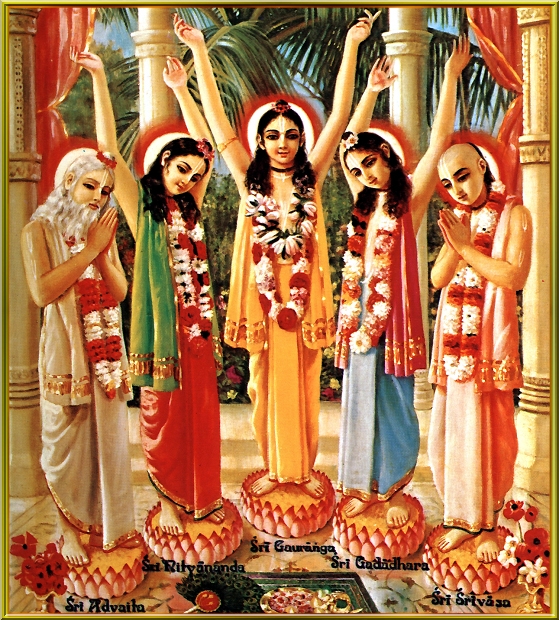 Amazing results were achieved in many preaching projects and activities of Iskcon around the world! Read more ›
Amazing results were achieved in many preaching projects and activities of Iskcon around the world! Read more › Seva and it’s beauty whilst breaking from the modes of material nature
→ simple thoughts
Last month after being asked to give class I spent time studying at the time I was asked if it was possible to comment on the words of Srila Rupa Gosvami regarding dhakti, sadly before giving class my glasses broke and I was unable to read my notes and didn’t cover it. One of the notation’s from Srila Prabhupada was as follows:
The exclusive nature of devotional service has also been described by Śrīla Rūpa Gosvāmī in the Bhakti-rasāmṛta-sindhu (1.1.11):
anyābhilāṣitā-śūnyaṁ jñāna-karmādy-anāvṛtam ānukūlyena kṛṣṇānu-śīlanaṁ bhaktir uttamā
“When first-class devotional service develops, one must be devoid of all material desires, knowledge obtained by monistic philosophy, and fruitive action. The devotee must constantly serve Krishna favorably, as Krishna desires.”
Pure devotees are so exclusive in their intent to serve the Supreme Lord without any reward that they do not accept any kind of liberation, even though it may be offered by the Supreme Lord. This is confirmed in the Śrīmad-Bhāgavatam (3.29.13).
There is also something called “mixed bhakti,” which occurs before the stage of pure devotional service. It is sometimes called prākṛta-bhakti, or devotional service mixed with material desires. Śrīla Prabhupāda writes, “When one has even a tinge of personal interest, his devotion is mixed with the three modes of material nature” (Bhāg. 3.29.9, purport). Thus mixed devotion can occur in various combinations within the modes of ignorance, passion, and goodness. Śrīla Prabhupāda elaborately explains mixed devotion as follows:
Devotional service in the modes of ignorance, passion, and goodness can be divided into eighty-one categories. There are different devotional activities, such as hearing, chanting, remembering, worshiping, offering prayers, rendering service, and surrendering everything, and each of them can be divided into three categories. There is hearing in the mode of passion, in the mode of ignorance, and in the mode of goodness. Similarly, there is chanting in the mode of ignorance, passion, and goodness, etc…. One has to transcend all such mixed materialistic devotional service in order to reach the standard of pure devotional service. [Bhāg. 3.29.10, purport]
One kind of mixed devotional service is known as jñāna-miśra-bhakti, or devotional service mixed with empiric knowledge. Śrīla Prabhupāda writes, “People in general, who are under the influence of avidyā-śakti, or māyā, have neither knowledge nor devotion. But when a person who is a little advanced and is therefore called a jñānī advances even more, he is in the category of a jñāna-miśra-bhakta, or a devotee whose love is mixed with empiric knowledge” (Bhāg. 4.9.16, purport).
Narada Bhakta Sutra 1.9
Over the time I’ve heard of individuals who have left the movement because of problems with devotee’s or quote some incident regarding a devotee or group of devotee’s as a reason to ridicule the movement.
I’ve been pondering this term prak ta-bhakti or service mixed with material desire and how Srila Prabhupada notes how this is devotion mixed by one of the three modes of material nature, my thought is what we see and note is the symptoms of our material conditioning.
We try our best but as we chose this material body we remain under the influence of material nature and thus this influence manifests itself when it comes to our seva. But we are trying to break free from Maya’s clutches and so the greatest privilege is being engaged in devotional seva.
Krishna and the devotee’s are so kind that they engage us nicely and accept what little we have to offer eventually down to this steady engagement we become less influenced by material nature.
In the mean time because of the conditioning our seva may not always be what it should be but I’m sure like me you hope those who see your efforts appreciate this and overlook our weaknesses and failings whilst forgiving any offences.
It occurred to me how kind Krishna and the devotee’s are not expecting us to be pure before doing seva.
It also reminded me that if we want others to show and appreciate our efforts we also have to change our mentality or should I say I have to change, rather than seeing faults seeing the beauty in the seva being done.
It reminded me of the fly and bee analogues and how we need to develop this bee mentality, for in a rubbish dump the bee would only see the one small flower and ignore the rest, whilst the fly even in a beautiful garden will only see the small stool in the garden.
Yes at times we see or hear of event’s when devotees have not quite conducted themselves correctly I know I’m guilty of this but then I’m trying to break free from my material conditioning. As so are many who come into the devotee society so there will at times be difficulty
And this is were we get to develop our compassion for the fallen conditioned soul, we can learn forgiveness and learn to appreciate the beauty of each small act of devotional service.
This was my thoughts whilst reading on this subject but as always what’s your thought’s?
1 May 2014 17:40:44
Lord Caitanya, the One who revealed relationships with Krsna beyond that of servitude (Part 1)
→ SivaramaSwami.com
English/Turkish.
The post Lord Caitanya, the One who revealed relationships with Krsna beyond that of servitude (Part 1) appeared first on SivaramaSwami.com.
Jahnu Saptami – The Lord’s blessings are more than worth whatever austerity is required to get them
→ The Spiritual Scientist
Chandana Yatra – By the sweat shed to save the Lord from sweat, we shed our material attachments and savor supreme fulfillment
→ The Spiritual Scientist
Shankaracharya – Reconcile apparent differences by focusing on unifying deeper purpose
→ The Spiritual Scientist
Helping Gourangi
→ Life With the Cows and Land
The recent video we published showed artk and treats being offered to the cows. After the ceremony, Gourangi and the rest of the cows were let out on pasture. As you know, Gourangi has been having trouble with arthritis in her legs. She kept up with the herd as they went out on pasture although she was moving very slowly. The video even shows her receiving a treat while on pasture.
A few days ago, we found her sitting in the lower pasture unable to get up. We knew we had to move her as there are coyotes in the woods. This slideshow shows how we moved her and how she is now staying in the old cow shelter that was built last year. Indraneela and Anasuya (the two calves rescued from the auction barn last fall) are keeping her company. They can be seen snuggling with her. Since Indraneela and Anasuya were taken from their mothers at an early age, we think they perceive Gourangi as a mother figure.
Gourangi is 19 years old which would make her 95 years old in human years.She has not been able to get up and is becoming weaker.She is listening to Srila Prabhupada chanting the Hare Krsna mantra and singing bhajans. She has received dust from Govardhan Hill in Vrindavan, India. If you could please join us in praying for her. Thank you.
Can you explain the difference in the defects of being illusioned and committing mistakes as illustrated through the evolution theory?
→ The Spiritual Scientist
From Gopi Vallabhi Devi Dasi
We are glad to present this old footage of HH Mahavishnu Swami, preaching at the…
→ Mahavishnu Swami
https://www.youtube.com/watch?v=yBktsg9SCbw

Mahavishnu Swami Lecture+Kirtan | University, Swansea, October 1997
Mahavishnu Swami giving a Lecture and chanting Hare Krishna Kirtan at a University Hall Programme in Swansea, Wales, around Mid-October 1997 Continue reading
Are the demigod worshipers in Gita 9.15 different from normal karma kandis because the Gita refers to them as jnanis?
→ The Spiritual Scientist
From Radhika Nagara P
Monthly Bhajans at New Vrindaban Fri. May 2, 2014
→ New Vrindaban Brijabasi Spirit
Do the ekatvena worshipers of Gita 9.15 refer to 9.11-12 or 12.3-6?
→ The Spiritual Scientist
From Radhika Nagara Prabhu
Tuesday, April 29th, 2014
→ The Walking Monk
It Started With A Cardinal
I spotted a cardinal bird, which is a sign of spring.
“It’s a female,” said Manorama, who’s quite the outdoorsy type. He knows his wildlife and his herbs. “The male’s colour is more intense,” he explained more. “The cardinal is a very aggressive bird, it’s been known to hop on to your rear view mirror and poke at it when seeing his reflection. He takes that mirror image as a competitor, and so he pecks away at it very hard, at the mirrored object, to the point where he hurts himself and gets all bloody.”
Manorama was giving a mild lesson on this red bird’s dynamics in the midst of our discussing this summer’s youth bus tour. “Great lesson about nature,” I thought. Nature is harsh.
My hosts in this district of Alachua are Ananta Sesa and Vaishnavi, both of South Indian origin. They reside with their two sons, Aravind and Gopal. They had arranged a picnic in the town’s park which has a typical Floridian forest trail. Jagannatha, Vaikuntha, and son, Dhira, along with one of the very few monks in the area, Janudwipa, took to the trail with me, at least a small portion of it. Conversations began about large temple constructions going on in various places in the world. We were talking about the expansion of Krishna Consciousness in places like India, Russia, Eastern Europe, pockets of South America and Africa, where there is exponential growth. North America seems to be lagging behind a little bit in terms of growth.
When we look at a response in North America from the public, it is rather good. People are either curious or just downright friendly, but not always so committal. One thing to admit to is that our marketing approach needs some adjustment. I’ve seen it work in places like Gainesville where young people are joining what we call, Krishna House.
Our evening wrap up occurred at the very home where I’m staying. A host of people from various backgrounds, including some neighbours, showed up. After kirtan, we discussed the nature of the mind, since that is what we all contend with on a daily basis.
I opened up the discussion to all. This is food for thought.
The mind:
1) The centre of the senses.
2) The sixth sense.
3) The subtle sense.
4) It is fickle.
5) It is like a switch.
6) It’s either a friend or a foe.
7) It possesses a good and bad side.
8) It’s a storage unit of thoughts.
9) A river of thought.
10) It can elevate you when controlled and degrade you when it controls you.
11) It can enslave you.
12) It is a connector.
13) It is the reigns of the wild horses (senses) pulled by the driver (intelligence) of the chariot (the body) and bewilders the passenger (the soul).
14) It’s a rascal, a monkey, a clown.
15) It’s like money, here today, gone tomorrow.
16) Befriend it and it works in your favour.
May the Source be with you!
5 KM
Monday, April 28th, 2014
→ The Walking Monk
Cleanse For Glory
Angelo and I and a few other individuals made our way to Main Highway with meditation beads in hand, and then down to a quiet road which accesses the ocean. It was my second trip here this morning. A police cab was parked on that road very close to the water’s edge. On my first venture over here, however, alone at 4 AM, it was a parked car that likely facilitated two lovers. Who knows. I’m not that curious.
Angelo had remarked that he like the fact that he parked ourselves (I mean buttocks) to a concrete block to be by the waves for gaining a sense of peace. I concurred saying, “Chanting by the sound of moving water can do a lot to clear the cobwebs of the mind.”
My visit to Miami terminated. Goodbye, Miami, and hello Orlando.
Here, I was driven to the new home of Abhimanyu Arjuna for a housewarming event, Vedic style. Raghu, a young priest from near Gainesville, drove the distance to perform the homa (fire ceremony). For Jamie and Chuck, who are local yoga instructors, viewing the ceremony was a new experience. Again, here was a ritual, like the chanting by the ocean in the morning, which serves to cleanse or purify the consciousness.
Considering the materialistic world in which we live with all its crazy demands, we need all the help we can get. It’s important to remind ourselves and each other in a regular manner that we consider to make our exit from this life after a good cleansing. Who wants to leave this world with a bad or sick heart? No one in their right mind would want that. It’s principles of forgiveness and gratitude that permit a glorious parting. That’s why all the chanting, purifying rituals, wholesome interaction, etc., make a difference in changing the shape of our destiny.
May the Source be with you!
7 KM
Aryan Invasion Theory – Origins, Problems and Consequences
→ The Spiritual Scientist
Problems with the Aryan invasion theory
(Adapted from A Survey of Hinduism by Klaus Klostermaier)
1. Unsubstantiated Linguistic Conjecture: The Aryan invasion theory is based purely on linguistic conjectures, which are unsubstantiated.
- 2. Other kingdoms already in place: The supposed large-scale migrations of Aryan people in the second millennium bce first into western Asia and then into northern India (by 1500 bce) cannot be maintained in view of the established fact that the Hittites were in Anatolia already by 2200 bce and the Kassites and Mitanni had kings and dynasties by 1600 bce.
3. No reference in relevant literature: There is no hint of an invasion or of large-scale migration in the records of ancient India: neither in the Vedas, in Buddhist or Jain writings, nor in Tamil literature. The fauna and flora, the geography, and the climate described in the Ṛgveda are those of northern India.
4. Cultural continuity: There is a striking cultural continuity between the archaeological artifacts of the Indus-Sarasvati civilization and later phases of Indian culture: a continuity of religious ideas, arts, crafts, architecture, and system of weights and measures.
5. Archaeological similarity before and after the supposed invasion: The archaeological finds of Mehrgarh dated ca. 7000 bce (copper, cattle, barley) reveal a culture similar to that of the Vedic Indians. Contrary to former interpretations, the Ṛgveda reflects not a nomadic but an urban culture.
6. The missing horse is no longer missing: The Aryan invasion theory was based on the assumption that a nomadic people in possession of horses and chariots defeated an urban civilization that did not know horses and that horses are depicted only from the middle of the second millennium onward. Meanwhile archaeological remains of horses have been discovered in Harappan and pre-Harappan sites; drawings of horses have been found in Paleolithic caves in central India. Horse drawn war chariots are not typical for nomadic breeders but for urban civilizations.
7. Similar racial diversity in skeletons: The racial diversity found in skeletons in the cities of the Indus civilization is the same as in today’s India; there is no evidence of the coming of a new race.
8. Advanced astronomy: The astronomical references in the Ṛgveda are based on a Pleiades- Kṛttika calendar of ca. 2500 bce. Vedic astronomy and mathematics were well-developed sciences: these are not features of the culture of a nomadic people.
9. Destruction due to desertification, not invasion: The Indus cities were not destroyed by invaders but deserted by their inhabitants because of desertification of the area. Strabo (Geography XV.1.19) reports that Aristobulos had seen thousands of villages and towns deserted because the Indus had changed its course.
10. Advanced architecture prior to supposed invasion: Excavations in Dvaraka have led to the discovery of a site larger than Mohenjo Daro, dated ca. 1500 bce with architectural structures, use of iron, and a script halfway between Harappan and Brahmi. Dvaraka has been associated with Kṛishna and the end of the Vedic period.
11. Continuity in scripts: There is a continuity in the morphology of scripts: Harappan— Brahmi—Devanagari.
12. Long Puranic dynastic lists: The Puranic dynastic lists, with over 120 kings in one Vedic dynasty alone, date back to the third millennium bce. Greek accounts tell of Indian royal lists going back to the seventh millennium bce.
13. Vedic culture too advanced for nomads: The Ṛgveda shows an advanced and sophisticated culture, the product of a long development, “a civilization that could not have been delivered to India on horseback.”
14. Idea of a nationwide historical amnesia absurd: It would be strange indeed if the Vedic Indians had lost all recollection of such a momentous event as the Aryan invasion in supposedly relatively recent times—much more recent, for instance, than the migration of Abraham and his people, which is well attested and frequently referred to in the Hebrew Bible.
Sunday, April 27th, 2014
→ The Walking Monk
A Small Band of Us
A small band of us trekked to the ocean, and on our way we passed by a pizza shop which looked to be a 24/7 outfit. The owner of the shop came out and broke out into a chant when he saw us. It turns out that he knows one of our boys, a monk who passed away no less than two years ago.
“I love that guy,” said the pizza man with his hand to his heart.
“You mean, Siddha Vidya, my god brother monk?”
“Yeah, that’s the guy, that’s his name,” he said. “I’ll make some pizzas for you guys,” and we declined saying it’s a little early in the morning. It was 5:30 AM.
Those of us who walked together knew of this extraordinary soul – Siddha Vidya, who made an impression on so many people with his visits to shop owners. He made so many friends with all the people he had met.
Now, we continued on through Peacock Park, where hippies frequented, played Frisbee and enjoyed the food and fun that Krishna monks provided in the ‘70’s. Vishnujana Swami, a most renowned monk of his time, drew the crowds.
Much later in the day, or let’s say at 1-ish, a second group of us made our way to the docks for a boat ride and swim. The operator of the boat called “Pearson” with the Shake A Leg establishment, was one of those guys that used to hang out at Peacock Park with the Krishnas in the ‘70’s. Being sensitive about our needs, he took us to a beach area away from the sex, drugs, and rock and roll scene, bless his heart. Hence, we played hard in the water. I still prefer fresh water though. Jambavan, from Michigan, was with us, and told about his father’s t-shirt, which held a caption in support of the Great Lakes, where there’s fresh water. The caption read, “No Sharks, No Salt, No Worries”. When I asked the operator of the boat about sharks in the area, his facetious response was, “Whoever amongst you is a poor swimmer, just keep him near you.”
The evening wrapped up at the ISKCON Centre with Jambavan and I doing a duet on the Gita’s message. I will also say that the kirtan that preceded it was electrifying.
May the Source be with you!
8 KM
Saturday, April 26th, 2014
→ The Walking Monk
Construction updates of probably the largest ISKCON temple after Mayapur, Iskcon Kanpur (Album 28 photos)
→ Dandavats.com
 The second-largest ISKCON temple in the world, after ISKCON’s headquarters in Mayapur, is set to open in Kanpur on October 3rd, 2014. The festival is expected to draw over 100,000 people including over 500 ISKCON devotees.
Construction on the temple began in October 2011 and will conclude this August. Set on a fifteen-acre site, the elaborate 100,000 square-foot temple, with its majestic towers, will include an open-sky courtyard and large temple hall.
On the temple’s three altars devotees will worship Sri Sri Gaura Nitai, Sri Sri Radha Madhava, and Sri Sri Sita Rama, Lakshman and Hanuman. And wrapping around the building will be a Parikrama marg, or pilgrimage path.
In its first phase of construction, the project will also include a 60,000 square-foot Vedic Ashram, a guest house, Food For Life center, community hall, Bhaktivedanta Youth Academy, gift shop, Govinda’s restaurant, a Goshala housing sixty cows, and a Bhaktivedanta Book Library with a conference hall. Read more ›
The second-largest ISKCON temple in the world, after ISKCON’s headquarters in Mayapur, is set to open in Kanpur on October 3rd, 2014. The festival is expected to draw over 100,000 people including over 500 ISKCON devotees.
Construction on the temple began in October 2011 and will conclude this August. Set on a fifteen-acre site, the elaborate 100,000 square-foot temple, with its majestic towers, will include an open-sky courtyard and large temple hall.
On the temple’s three altars devotees will worship Sri Sri Gaura Nitai, Sri Sri Radha Madhava, and Sri Sri Sita Rama, Lakshman and Hanuman. And wrapping around the building will be a Parikrama marg, or pilgrimage path.
In its first phase of construction, the project will also include a 60,000 square-foot Vedic Ashram, a guest house, Food For Life center, community hall, Bhaktivedanta Youth Academy, gift shop, Govinda’s restaurant, a Goshala housing sixty cows, and a Bhaktivedanta Book Library with a conference hall. Read more › Was Hitler interested in India’s ancient spiritual culture? If yes, then why was he so hateful towards Jews?
→ The Spiritual Scientist
May 1st, 2014 – Darshan
→ Mayapur.com
The post May 1st, 2014 – Darshan appeared first on Mayapur.com.
“…another miracle occurred!”
→ Dandavats.com
 After Prabhupada chanted "Narayan", there was an eerie silence for about 20 seconds at the end. Finally Prabhupada concludes the lecture saying "Thank you very much". After I heard the pause two or three times, I was convinced Prabhupada went into trance calling the names of Narayana. I wanted to verify my doubt so I did some research online to find if there were any eye witness to this lecture. Lo and behold I found a passage about this encounter by Satyaraja Dasa (Steven Rosen) in his book "The Agni and the Ecstasy". Read more ›
After Prabhupada chanted "Narayan", there was an eerie silence for about 20 seconds at the end. Finally Prabhupada concludes the lecture saying "Thank you very much". After I heard the pause two or three times, I was convinced Prabhupada went into trance calling the names of Narayana. I wanted to verify my doubt so I did some research online to find if there were any eye witness to this lecture. Lo and behold I found a passage about this encounter by Satyaraja Dasa (Steven Rosen) in his book "The Agni and the Ecstasy". Read more › HG Maha Hari Prabhu / SB 10.60.35
→ Kalachandji's Audio Archive
A Glimpse into Krishna Consciousness, Los Angeles (35 min video documentary)
→ Dandavats.com
 We originally wanted to make this documentary to start an abrupt filmmaking career with projects planned to follow. Little did we know, Krsna (God) had bigger and better plans for us. We are now living in the ashrams depicted in the video with faith and determination on the path to spiritual advancement. Read more ›
We originally wanted to make this documentary to start an abrupt filmmaking career with projects planned to follow. Little did we know, Krsna (God) had bigger and better plans for us. We are now living in the ashrams depicted in the video with faith and determination on the path to spiritual advancement. Read more › Devamrita Swami 04-20-2014 Sunday Feast
→ Gouranga TV - The Hare Krishna video collection
Devamrita Swami 04-20-2014 Sunday Feast
How to make the whole world peaceful and prosperous just by Eating and Dancing?
→ The Spiritual Scientist
The Krishna consciousness movement is based on this principle: chant the Hare Krishna mantra at every moment, as much as possible, both inside and outside of the temples, and, as far as possible, distribute prasada. This process can be accelerated with the cooperation of state administrators and those who are producing the country’s wealth. Simply by liberal distribution of prasada and sankirtana, the whole world can become peaceful and prosperous.
- Srila Prabhupada, Srimad Bhagavatam 4.12.10
New Vrindaban’s Transcendental Throwback Thursday – 05/01/14
→ New Vrindaban Brijabasi Spirit
New Vrindaban’s Transcendental Throwback Thursday – 05/01/14.
Each week we highlight an earlier era of ISKCON New Vrindaban.
This week’s challenge: In this famous photo, there are two devotees & a cow. Can you name all three?
Extra Credit: What year was this photo taken?
Post your guesses on the “who, what, when, where & why” in the comment section at the New Vrindaban Facebook Page.
Technical stuff: We share a photo Thursday and confirm known details Sunday. Let’s keep it light and have a bit of fun!
Special request: If you have a photo showing New Vrindaban devotees in action, share it with us and we’ll use it in a future posting.
ISKCON Scarborough – Srimati Sita Devi’s appearance day and upcoming Mother’s day celebrations
→ ISKCON Scarborough
Please accept our humble obeisances!
All glories to Srila Prabhupada!
All glories to Sri Guru and Sri Gauranga!
Friday - 2nd May 2014:
Srimati Sita Devi's (Consort of Lord Sri Rama) appearance day anniversary falls on May 1st 2014(Thursday).
At ISKCON Scarborough we will be celebrating this wonderful event on Friday May 2nd 2014
Srimati Sita Devi is an eternal consort of Lord Ramachandra.
She is known to be the daughter of Bhumidevi, the goddess of earth. In Treta-yuga, she appeared to King Janaka in Mithila while he was ploughing the earth.
King Janaka who was the ruler of Janakapuri was childless. When Janaka Maharaj was ploughing a piece of land he unearthed a golden casket in which he found a beautiful girl baby. A land ploughed by the yoke is called 'Sita', and so he named the baby as Sita.
She was later married to Lord Ramachandra and joined him when he was banished to the Dandakarnaya forest. Despite being kidnapped by the demom King Ravana, she remained faithful to Lord Rama, who eventually killed Ravana. She had two illustrious sons Luv and Kush.
She is addressed by several names such as Maithili (princess of Mithila), Janaki (daughter of Janaka), Rama (wife of Lord Ram), etc. She is a central figure in the Ramayana and an embodiment of qualities such as chastity, forgiveness, self-discipline, simplicity and gratitude. Srimati Sita Devi is also the manifestation of the goddess of fortune. On her auspicious appearance day, devotees can aspire for Their Lordships Sita Rama to bestow sincere devotional service and qualities upon them.
Mother’s day Special programs - Friday- May 9th, Saturday May 10th and Sunday May 11th 2014
Similar to the wonderful Mother’s day festivities we had in ISKCON Scarborough last year, we will again be celebrating Mother’s day (Sunday May 11th 2014) in a grand manner this year.
This year we are expanding the Mother’s day celebrations throughout the weekend. Special programs are arranged on Friday and Saturday to honor and thank the Mothers and the celebration will culminate in a grand Mother’s day festivities on Sunday May 11th 2014.
We warmly invite all the devotees with their friends and family members to ISKCON Scarborough to partake in the special celebrations:
- Sita Jayanti on Friday – May 2nd (Program starts at 6.45 pm)
- Mother's day programs on Friday- May 9th (Program starts at 6.45 pm), Saturday May 10th (Program starts at 6.45 pm) and Sunday May 11th 2014(Program starts at 10.30 am)
ISKCON Scarborough
3500 McNicoll Avenue, Unit #3,
Scarborough,Ontario,
Canada,M1V4C7
Email Address:
iskconscarborough@hotmail.com
website:
www.iskconscarborough.com



